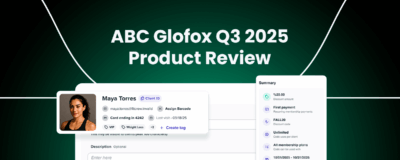Table of Contents
- Day to Day Operations: KPIs Every Gym Should Track
- Fitness Dashboards and Data Tracking for SMBs
- Why SMBs Need Pro-Level Reporting Tools
- FAQs – Gym Operations and Reporting
- So, What’s Next?
TL;DR: Managing day to day operations comes down to tracking essential KPIs and using fitness dashboards to gain real-time insights into the health of your business. ABC Glofox simplifies this process, helping single- and multi-location gym owners save time and make data-driven decisions that improve performance and drive growth. |
You open the gym at 5 a.m. for early morning classes. By 6 a.m., you’re troubleshooting a billing issue. At 7 a.m., you’re responding to member emails. By noon, you’re interviewing a new instructor while simultaneously trying to figure out why last month’s retention numbers dropped.
Sound familiar?
Your gym needs to run on more than passion to be successful. The reality is that day to day operations can make or break your business. Between scheduling classes, tracking revenue, managing staff, and keeping your members happy, the operational side of gym ownership often gets overwhelming.
The good news? The right systems and processes can transform your daily grind into a smooth operation. In this guide, we’ll break down the essential franchise KPIs every gym should track, explore how fitness dashboards simplify data management, and show you why pro-level reporting tools aren’t just for big chains anymore.
Ready to see what a streamlined day looks like? Download our free eBook: A Day in the Life with ABC Glofox to discover how gym owners use our platform to reclaim their time and manage their day to day business operations!
Download Ebook
Day to Day Operations: KPIs Every Gym Should Track
Understanding your gym’s performance starts with tracking the right metrics. KPIs (Key Performance Indicators) give you a clear picture of your business health and help you make smarter decisions instead of relying on gut feeling.
Here are the essential franchise KPIs that every gym owner should monitor:
Member retention rate
This metric shows the percentage of members who stay with your gym over a specific period.
Example: If you started January with 200 members and ended with 180, your retention rate is 90%.
High retention means your members are satisfied and your gym is sticky. Low retention signals you need to improve the member experience. Tracking this metric monthly helps you spot trends over time and proactively address issues.
Monthly recurring revenue (MRR)
MRR represents the predictable revenue your gym generates each month from memberships.
So if you have 100 members paying $150 per month, your MRR is $15,000.
This number indicates whether your business is growing, stable, or declining. It’s the most important financial metric for planning expenses, hiring staff, and making investment decisions.
Average revenue per member (ARPU)
ARPU indicates the average revenue generated by each member.
You can calculate ARPU by dividing total revenue by total number of members. If your gym made $20,000 last month from 100 members, your ARPU is $200.
This metric helps you understand if your pricing strategy is effective and whether upselling services, such as personal training or nutrition coaching, is successful.
Class/session utilization rates
This metric measures how full your classes are compared to capacity.
For instance, if your 6 a.m. spin class has 20 spots but only 8 people show up, that’s a 40% utilization rate.
High utilization means you’re meeting demand. Low utilization might mean you need to adjust class times, improve your marketing, or reconsider which classes you offer. This data helps prevent you from paying instructors for empty classes.
📝 Read More: How to Make the Most of Your Fitness Class Booking App in 2025
Lead conversion rate
This data point tracks the percentage of inquiries that become paying members. If 50 people tour your gym and 10 sign up, your conversion rate is 20%.
A strong conversion rate means your sales process is working as intended. A weak rate signals problems with pricing, sales skills, or how you showcase your gym’s value. Improving this metric directly impacts your bottom line without spending more on marketing.
Why tracking these KPIs keeps small gyms competitive
Far from just numbers on a spreadsheet, these metrics indicate the health of your business and pinpoint exactly where it needs support.
When you track them consistently, you’re in a position to spot problems early, capitalize on opportunities quickly, and make decisions based on data instead of guesswork.
The difference between struggling gyms and successful ones often comes down to who’s watching the numbers.
📝 Check Out: Day to Day Business Operations – The Complete Guide for Gym Owners
Fitness Dashboards and Data Tracking for SMBs
Raw data means nothing if you can’t understand it quickly. That’s where fitness dashboards come in.
A good dashboard turns your gym’s performance data into easy-to-understand visual information you can access anytime, anywhere. So instead of digging through spreadsheets or waiting for month-end reports, you can get real-time insights at a glance.
Some examples of fitness dashboards for managing day to day business operations:
- Membership reports show active members, new sign-ups, cancellations, and retention trends. You can see exactly who’s staying and who’s leaving.
- Revenue reports break down income by source, including memberships, personal training, retail, and more. You’ll know which services drive the most profit.
- Leads conversion reports track your pipeline from inquiry to conversion. You can identify where potential members drop off in your sales process and coach your team accordingly.
- Class performance reports reveal which classes are popular, which are underperforming, and when your gym is busiest. This data helps you adjust your gym class schedule accordingly..
Fitness dashboards save you hours of manual data entry and provide instant visibility into what’s working and what needs attention.
📝 Check Out: Fitness Studio Tech Stack – Essential Tools for Success
Why SMBs Need Pro-Level Reporting Tools
Many small gym owners start with basic tools like spreadsheets and notebooks to track what’s happening in their business. Unfortunately, these manual methods can create real problems as your business grows.
Let’s break it down:
- Manual spreadsheets are time-consuming and prone to errors. One wrong formula and your revenue projections can be off by thousands.
- Plus, your data lives in multiple places—membership info in one system, billing in another, class schedules somewhere else. This fragmentation makes it nearly impossible to see the complete picture of your business.
- Inconsistent data becomes another headache. When three different spreadsheets show three different numbers, which one is right? You waste valuable time reconciling numbers instead of growing your business. And you might make decisions based on inaccurate information.
📝 Read More: Save Time and Money – How ABC Glofox Replaces 5 Tools with One Platform
Benefits of adopting fitness management software
The right gym management software solves these problems by centralizing everything in one place.
Real-time reporting ensures you always have access to current data. Plus, mobile access lets you check your business from wherever you are—whether you’re at your kid’s soccer game or meeting with a potential investor.
The Top 10 Barriers
Slowing Your Fitness
Business Growth
Discover more Scaling your fitness franchise becomes significantly easier with the right tools. For instance, ABC Glofox allows multi-location operators to view performance across all sites or drill down into individual locations.
→ You can quickly compare which location has the best retention, highest revenue per member, or most efficient class utilization. This information makes it easier to replicate what works and fix what doesn’t.
“ABC Glofox offered the automation and customer support we needed to scale effectively.”
– Daniel Stein
Founder, Special Strong

How ABC Glofox simplifies reporting for both single and multi-location operators
Our platform provides intuitive fitness dashboards that track all your essential metrics in real-time. You’ll get:
- Automated reports delivered straight to your inbox
- Customizable views based on your priorities
- Accurate data because everything connects to one system
ABC Glofox saves single-location studio owners hours of administrative work. It’s easy to quickly see which classes are full, which members need follow-up, and whether or not you’re hitting your revenue targets.
For multi-location operators, our system provides consolidated regional reporting across all sites, while individual gym managers can access their specific performance data. The time you’d typically spend drowning in spreadsheets can be redirected toward coaching members, training staff, and strategically growing the business.
Better reporting tools give you your time back, period.
📝 Read More: How ABC Glofox Uses Data to Boost Your Business Growth
FAQs – Gym Operations and Reporting
What are day to day operations?
Day to day operations refer to the routine tasks and activities required to keep your business running smoothly.
For gyms, this includes opening and closing the facility, managing member check-ins, responding to inquiries, scheduling and running classes, handling billing and payments, addressing member questions, managing staff schedules, and maintaining equipment.
Day to day operations are the essential activities that happen every single day to deliver value to your members and keep your business functioning.
What does the day to day operation of a gym actually involve?
Running a gym involves juggling multiple responsibilities at once.
Your morning might start with unlocking the facility and greeting early members. You’ll troubleshoot equipment issues, answer phone calls and emails from prospective members, and ensure your scheduled classes have instructors.
Throughout the day, you’re processing payments, managing cancellations, monitoring class attendance, and addressing member questions or feedback.
You’re also handling administrative tasks like updating member records, reviewing financial reports, posting on social media, and following up with leads.
Staff management takes up significant time—creating schedules, conducting training, and addressing performance issues. And that’s just the operational side. You’re also thinking strategically about retention, growth, and how to improve the member experience.
The reality is that gym owners and managers wear many hats, and the daily demands can be overwhelming without proper systems in place.
📝 Check Out: Features and Benefits of Club Management Software
How do fitness dashboards help with daily gym management?
Fitness dashboards provide instant visibility into your operations.
For instance, reporting dashboards let you see everything in real-time instead of waiting for end-of-month reports or manually pulling data from multiple systems. This allows you to identify problems as they happen and fix them immediately.
So if your dashboard shows that 10 members haven’t visited in two weeks, you can reach out to them today with a personalized message. If class attendance drops suddenly, you can investigate and adjust before the trend continues.
Fitness dashboards also help with staff management. You can see which of your instructors are fully booked and which need more members assigned to them.
The visual nature of fitness dashboards makes complex data easy to understand at a glance. Plus, you don’t need to be a data analyst to know if your gym is performing well. Green numbers going up? Good. Red numbers going down? Time to take action.
What reporting tools do franchises use to track multiple gym locations?
Multi-location operators need reporting tools that provide both consolidated views and location-specific data.
ABC Glofox’s centralized dashboards show performance across all gyms, making it easy for you to compare locations and identify which ones are thriving and which need support.
At the same time, individual location managers need access to their own data to manage day to day operations effectively. Our platform addresses both needs.
The best reporting tools allow regional leaders to set benchmarks and track each location’s performance against company-wide goals. They also enable HQ to maintain brand consistency while giving individual locations flexibility to adapt to their local markets.
📝 Check Out: Business Expansion at Scale – A Strategic Guide for Multi-Location Fitness Operators
How can SMB gyms use regional reporting to improve performance?
Regional reporting is valuable even for smaller gyms with just two or three locations.
By comparing performance across sites, you can identify best practices and replicate what works. If Location A has a 95% retention rate and Location B has 80%, what’s the difference? Better communication? Stronger community? More engaged staff? Regional reporting helps you answer these questions.
You can also use regional data to optimize how you allocate resources. If one location consistently has high class utilization while another struggles, it’s time to shift instructors or adjust class schedules. Regional reporting ensures you’re not treating all locations the same when they have different needs and opportunities.
For franchise operators, regional reporting also helps ensure brand consistency across locations while still allowing individual locations to adapt to local market conditions. Reporting makes it easier to ensure that all locations meet minimum performance standards while giving high-performing locations the recognition they deserve.
📝 Check Out: How Multi-Brand Studios Unify the Member Experience
So, What’s Next?
Running a gym is complex, but it doesn’t have to be chaotic.
Your day to day operations become much more manageable when you track the right KPIs, leverage fitness dashboards, and use professional reporting tools. That’s because the most successful gym owners don’t just work harder—they work smarter.
ABC Glofox simplifies day to day business operations for gyms of all sizes with intuitive reporting tools, fitness dashboards, and insights you need to stay competitive.
Want to see how it all comes together? Download our FREE eBook, A Day in the Life with ABC Glofox, and discover how to streamline your operations and reclaim your time.














